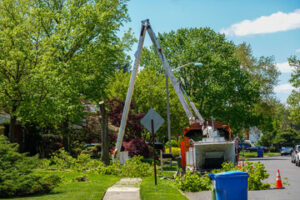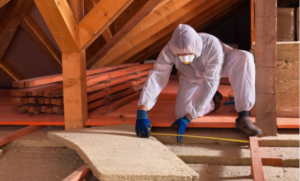St Charles Pest Control involves reducing or eliminating the presence of unwanted organisms. It’s a multi-step process that can include prevention, suppression and eradication.
Physical or mechanical methods prevent or limit pests by excluding them or restricting their access to food or shelter. Examples include sticky barriers, rodent bait stations and netting to keep birds from roosting on crops or buildings.

Keeping pests out of buildings and preventing them from getting inside is the best way to ensure health and safety in the workplace. Some common pests like rodents, ants and spiders can carry diseases such as Salmonella and hantavirus. Their fecal matter can also be a health hazard, triggering allergic reactions in some people. In addition, they can cause structural damage and chew wires that can lead to fire.
Oftentimes, these pests are the result of poor sanitation. Proper food storage and garbage disposal are essential to prevent pest infestations. Food should be stored in tightly closed containers, and trash must be disposed of promptly to avoid moisture build-up. It’s also a good idea to use dehumidifiers in rooms with high humidity.
Another important step to prevent pests is to regularly inspect a property for potential entry points. Pests exploit even the tiniest cracks and crevices, so sealing them is crucial. It’s also important to keep the exterior of a building free from debris and vegetation to eliminate hiding spots.
Regular inspections by licensed pest control technicians are another critical preventive measure. These professionals are trained to spot early signs of infestation and take the necessary steps to resolve the problem while upholding environmentally conscious practices and responsible methods.
The goal of prevention is to limit the need for chemical treatments. Integrated Pest Management (IPM) is a pest control strategy that prioritizes monitoring and education over aggressive treatments. The approach allows the use of fewer chemicals and maintains a healthy environment for employees, customers and visitors.
IPM focuses on limiting the supply of food, water and shelter to pests by removing their sources. This includes identifying and blocking entry points, such as the smallest cracks in the foundation or window frames. IPM also recommends removing weeds, trimming trees and shrubs and storing garbage in sealed containers.
Other preventive measures include putting up physical barriers and “pest proofing” a building to make it difficult for pests to enter in the first place. While this can be a lengthy process, it’s the most effective method of pest control in the long run.
Suppression
When prevention and avoidance tactics fail to eliminate pests, they may be used in combination with suppression techniques to create unfavorable conditions for the organisms. In some cases, this will eliminate the need for pesticide use. The most common suppression tactics are physical barriers that prevent pests from accessing crops or other desirable materials, as in netting and screens in greenhouses; physical removal of rodents and insects, such as trapping, swatting, or shooting; or mechanical means such as crushing or chewing. Several types of biological control agents are also employed. These include predators, parasitoids, and disease-causing microorganisms (pathogens). Pheromones, which are manufactured copies of natural insect odors, can be used to confuse male insects or to interrupt mating. Juvenile hormones, which are natural insect chemicals that keep the earlier stages of pests from maturing into normal adults, can also be used.
Suppression of a pest population is usually accomplished by reducing its reproductive capacity, so that the average number of offspring that survive to adulthood is less than the population’s density-dependent limit. Although this will reduce the size of the pest population, it will not normally eradicate it, because most natural populations are self-replacing and can withstand small reductions in reproduction.
Another approach to biological control is called augmentative or artificial biology, in which the number of a pest’s enemies in an area is increased. This can be done by introducing existing natural enemies from other locations, or by “mass-rearing” biological control agents in insectaries and releasing them in an infested area. In the latter case, there is often a time lag between the release of the enemy and its effect on the pest population.
Cultural controls are practices that disrupt the environment in which pests live, making it unfavorable for them. This includes such methods as crop rotation, cleaning tillage and greenhouse equipment, and managing irrigation schedules to avoid long periods of high relative humidity that encourage disease-causing pathogens. The use of physical barriers such as netting and fencing can deprive weeds and vertebrates of their comfortable habitat, while mulching can inhibit weed growth or discourage insect infestations.
Eradication
Pests cause a lot of problems for humans. They can contaminate food, clothing, and other daily-use items. They can also worsen certain medical conditions, such as asthma. This is why they should be eradicated as soon as possible. However, eradicating pests is a complicated task and requires that the proper combination of prevention and suppression measures be implemented.
To eradicate a pest, the population must be reduced below the level that it causes unacceptable harm. To achieve this, the correct combination of control methods must be applied over a large area. This may require a substantial investment of human and financial resources, especially in developing countries.
Eradication involves the use of chemical, physical or biological controls to eliminate a pest. Chemical controls include repellents that deter pests or insecticides that kill them. Chemicals often work faster than other types of pest control methods, and they can sometimes deliver instant results. However, they aren’t always effective because they can’t kill pests at every stage of their life cycle. For example, traditional flea treatments only kill fully grown fleas; the eggs and larvae of fleas continue to grow and reproduce. Chemicals can also pose health and environmental risks when they’re used improperly or in excess.
Biological pest control uses a pest’s own enemies to reduce its population. This may be achieved through the release of natural predators, parasites or pathogens. It can also involve bioengineering, such as the production and release of sterile insects or the use of pheromones. Biological control usually isn’t considered eradication because there is a time lag between pest populations increasing and the natural enemies taking effect.
Physical pest control uses traps, netting and other devices to remove the pest from the environment. These are more labor-intensive than chemical controls, but they may be less harmful to people and pets. These can be as simple as putting out a bait or as complex as constructing an owl sanctuary to capture rodents. However, the physical trapping of pests can be difficult and ineffective if the correct set of conditions aren’t met.
A clean environment is a key to eliminating pests. Make sure to regularly sweep up crumbs and other debris from the floors, and keep all kitchen surfaces, including the refrigerator, oven and counters, clean. Remove rotting fruits and vegetables from the house, and empty and rinse the garbage frequently. This will discourage pests, such as flies, ants and cockroaches, from finding food in the house.
Monitoring
Pest control services are an important part of maintaining public health and preventing damage to buildings, crops and the environment. These services protect people from diseases transmitted by rodents and insects, safeguard agriculture and food supplies, preserve property, and maintain ecological balance by preventing invasive species from disrupting ecosystems. Pest control methods include chemical, physical and biological techniques. They may involve the use of chemicals such as pesticides, physical barriers such as traps and barriers, or biological agents such as natural predators and pathogens.
The most common pests are rats, mice, cockroaches, flies, mosquitoes and spiders. Rodents and insects are carriers of disease-causing bacteria, viruses and parasites that can cause serious illnesses in humans. They can also destroy agricultural crops and cause costly property damage. Pests can also contaminate food, and they can cause asthma and other respiratory conditions in children and adults.
A pest control professional will visit your home and inspect it for signs of infestation. They will then develop a pest management plan that suits your situation and implement the appropriate control measures. The method chosen will depend on the type of pest, its location and how it is entering your property. For example, trapping may be more effective for a cockroach infestation than baiting.
Pests often have a frightening or grotesque appearance, and they can spread disease, contaminate food, damage property, and even threaten the safety of people and pets. Some pests, such as earwigs and silverfish, have a toxic venom that can be fatal to humans. Others, such as ants and wasps, are aggressive and can attack humans.
Some pests are considered vermin, which means they are a nuisance or danger to human society. Cockroaches, for instance, can carry Salmonella and E.coli, and their discarded body parts can trigger asthma attacks and allergic reactions in some people. They are also a significant source of irritation for residents in low-income neighborhoods, where they are a major problem.
The best way to avoid pest infestations is to keep food, water and garbage in sealed containers and to regularly dispose of waste in proper containers. In addition, pest-proofing your home and installing barriers to entry can help prevent a pest problem from developing. If you do have a pest infestation, a professional pest control service can take care of it quickly and efficiently.






